Bowl Shaped Bathroom Sink
- By
- Posted in Bathroom Essentials
- On April 4, 2019

History of Vessel Sinks
One of the must have bathroom trends these days is vessel bowl sinks. All the rage in bathroom remodel and new construction, these sinks have a misconception of being more suitable for modern and contemporary design. This assumption couldn't be further from the truth.
A quick history lesson for those that are interested: sinks themselves date back to the prehistoric times, but were then made from whatever material was available. Usually made out of rock that has been naturally eroded by weather to create a bowl shape, these sinks were laid on top of a surface to more conveniently access. In reality this was just a rudimentary form of the vessel sink we know today. Many years later, sinks were more commonly made out of metal and were placed inside a wooden structure, which is similar to modern day drop-in or undermount sinks.
What is a Vessel Sink?
A vessel sink is a sink, most commonly installed in a bathroom, that sits on top of the vanity countertop, unlike most commonly known undermount sinks that are installed under the counter.
What is a Semi-Recessed Vessel Sink?
A semi-recessed vessel sink is when part of the sink is mounted above the counter, and part is mounted below the counter. This type of mount is a more complicated install, as it requires a precision cut in the countertop for a perfect mount. The benefit of a semi-recessed sink is that the overall height of the vanity with sink is less than a vanity with a top mount vessel sink.

Can a Vessel Sink Be Fully Recessed?
Not all vessel sinks can be recessed into the countertop. If you would like to fully recess a sink, you need to buy one that has a rim on it. The rim provides a way for the sink to attach to the top when fully mounted. This too can be a more complex installation as it requires a precision cut in the countertop.
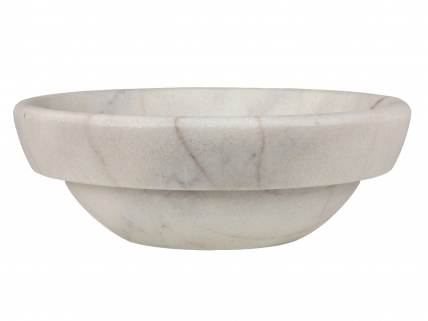
Pros and Cons of Vessel Sinks
Before you decide to add a vessel sink to your bathroom project, consider the advantages and disadvantages of these unique sinks.
Advantages
- Style: Adding a vessel sink really is something very unique, it has that wow factor when you see it. It's not something that you see in every bathroom. But you can find vessels in all kinds of shapes and styles. At Unique Vanities we have vessel sinks in glass and stone, including marble and granite. We also have a unique line of ceramic vessel sinks
- Easy to Install: In addition, they are very easy to install. It's simply cutting a hole into the countertop, depending on what kind of countertop you have. For most projects it's a very easy project for the do it yourselfer. Because it's so easy to install, you can easily change out the vessel sink in a year or two years down the road if you just wanted to change up the style of your overall bathroom.
- More Countertop Space: You also gain counter space by having the sink mounted on top.
Disadvantages
- Are vessel sinks in style or just a fad? Some designers consider it a fad that might not be around for the long term. At Unique Vanities, we disagree but it is something to take into consideration.
- Cleaning: There can also be water and dirt that can get stuck in between the base of the vessel sink and the countertop. So that too is just something to take into consideration.
- Durability: There can also be durability and sustainability issues. With vessel sinks, the edge is exposed. If it is a sink that you use day in and day out it may be more prone to potential cracks or damage. This is very rare, however.
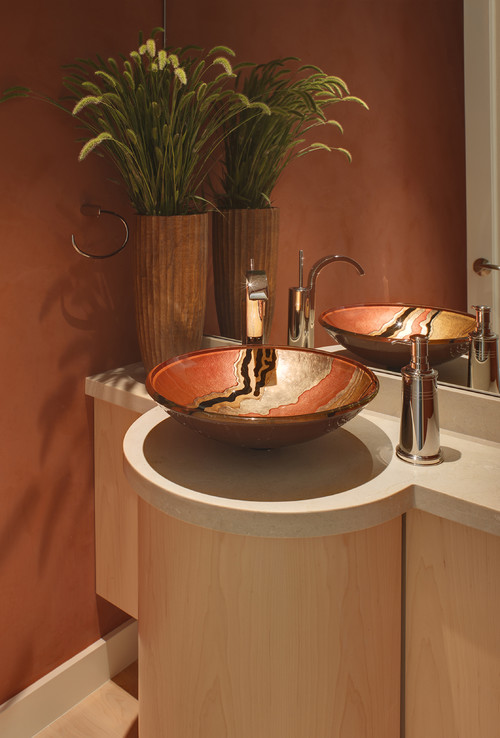
Other Considerations
- Special Faucet: A few other things you need to be aware of, they do require a special faucet. You will need a faucet that is tall enough for the water to fall into the bowl.
- Vanity Height: Also you should consider the height of your vanity. You want the sink to be easy to reach. If the vanity is a standard size, some sinks may end up being too tall and a little difficult to use.
Is a Mounting Ring Necessary for a Vessel Sink?
Mounting rings are not necessarily required when installing a vessel sink. They are ideal for sinks that have a round or curved base and need the mounting ring to stabilize the bowl on the countertop. They are most commonly used for light weight sinks, such as glass, or custom pottery sinks.
Can You Put a Vessel Sink on Any Vanity?
Technically you can put a vessel sink on any cabinet. The issues involved though include the height of the cabinet, whether it has an existing countertop or not, and your current plumbing.
You can purchase vanities that were designed for vessel sinks, which is ideal. But if you can't find a cabinet that fits your style, then the next best option is to purchase a vanity cabinet without a countertop. In this situation, you'll need to get a custom top fabricated and installed, and can have your fabricator prep the top for a vessel sink. But its important to consider the height of cabinet, as placing a countertop with a vessel sink on top can add 6 – 8 inches to the overall vanity height.
Plumbing issues arise if you need a wall mount vessel faucet, as this will require new plumbing lines in the wall. This is more complex than simply replacing a deck mount faucet.
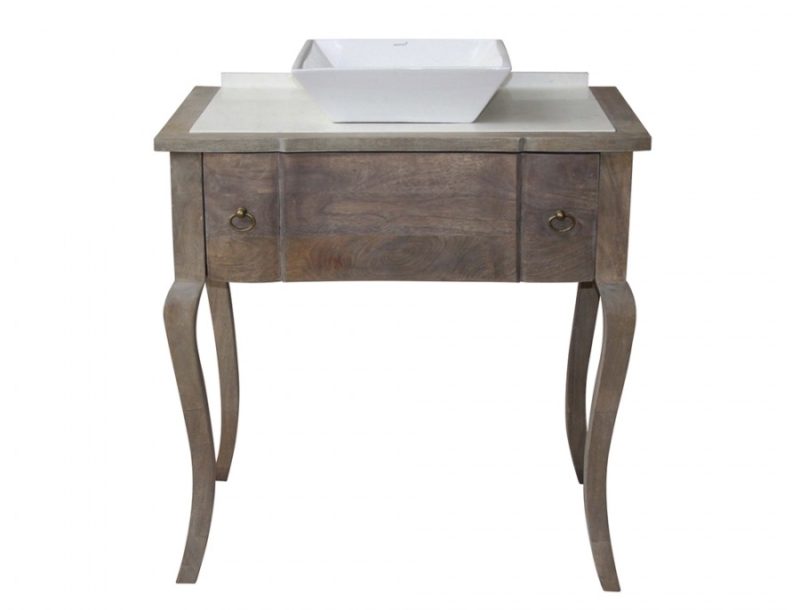
Do Vessel Sinks Have an Overflow?
Most vessel sinks do not have an overflow drain. But there are some exceptions to this. An overflow drain does require a sink drain with overflow, so make note of this when shopping vessel sinks.
Changing from a Standard Sink to a Vessel Sink
Are you thinking of changing your standard sink to something more new and modern looking like that of a vessel sink? Are you concerned that there is too much work involved to make the switch? Well, don't be. Changing from one to the other actually doesn't require that much effort, unless you are changing your faucets to be wall mounted. With a vessel sink, the faucet needs to be much higher in order to go over the top of the bowl. So if you decide on moving your bathroom faucets to the wall, rather than using a vessel sink faucet, you will be required to move the water supply lines inside of the wall. In addition to the faucet changes, you will also need to add a longer tail piece to the underside of your bathroom sink to lengthen the drain. Since vessel sinks sit on top of bathroom furniture, rather than underneath it, you'll need a connecting piece of drain to make the transition. Keep in mind as well, that you'll need to change the countertop too, as the old one will have a big hole in it from the old sink! But once you've done that you will have done it – and have a beautiful new vessel sink vanity to admire!
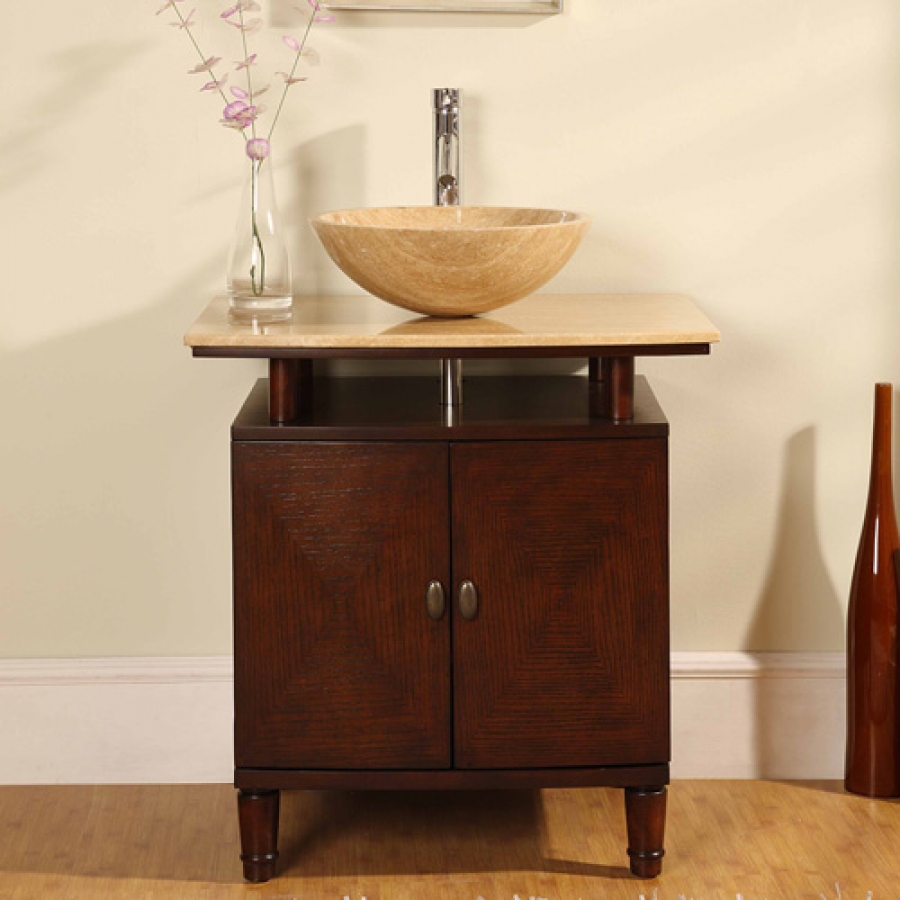
How to Choose a Vessel Sink?
Vessel sinks are an essential accessory that helps to improve the aesthetic value of bathrooms. If you are planning to install some new unique vessel bathroom sinks or replace the existing ones, you will find that there are many different types and styles to choose from. The most common styles from which you can choose one include glass, granite, copper, stone, wood, terrazzo, concrete, soapstone, plastic, marble, ceramic, stainless steel, and enamel-over-cast iron or steel vessel bathroom sinks. All these different types of materials, which are used to create different designs of vessel bathroom sinks, have their own pros and cons.
Glass sinks are the new and contemporary trend for vessel bathroom sinks. Beautiful glass vessel bathroom sinks have become a fashion symbol, and the choice style for wealthy homeowners. These sinks are so elegant yet highly functional. If you are looking forward to modernizing your home, you should go for these sinks. Additionally, with the variety of colors and patterns available, changing the entire theme of your bathroom decor is much simpler by changing out the glass vessel, rather than the entire vanity.
Stone sinks are the oldest style of vessel bathroom sinks. Stone-crafted sinks have been used for thousands of years. Some of the most popular stones for designing vessel bathroom sinks include granite, marble, onyx, soapstone and travertine. These kinds of sinks are great for a naturally-inspired modern home decor. Of all types of vessel bathroom sinks, they are the easiest to maintain. However, sinks made using quality, high-end stones such as marble are costly to build. Concrete, terrazzo and wood sinks are great alternatives that can be used to boost the aesthetic appeal of the bathroom. Wood furnishing can be used to complement other materials such as stainless steel.
Metal sinks are another common vessel bathroom sink style. The most popular metal sink styles are stainless steel, copper and enamel-over-cast iron. Stainless steel sinks are the most preferred style in commercial setting. This is because they are easy to clean, and cheaper to set up compared with the other styles. Stainless steel and copper sinks score highly in terms of usability and durability. Both of them are impact resistant, and cannot be damaged by very hot or cold objects.
If you choose to go with an aluminum or copper vessel sink you must keep in mind that it has a tendency to develop a protective oxide coating or patina when exposed to the atmosphere, it's not necessary to have additional treatment in ordinary surroundings unless you want to keep the original finish and coloring. Special alloys and anodic coatings are applied in extra-corrosive surroundings. Talk to your manufacturer or retailer about this and they will guide you in how to care for your metal sink. A good retailer will be there for you for many years to come with your new sink.
Enamel-over-cast iron vessel bathroom sinks are heavy and durable. They come in a wide variety of designs featuring many different shapes and colors. Like steel and copper sinks, they cannot be damaged by very hot or cold items. However, their glass surface can break under sharp impact. Once it is breached, the cast iron set inside starts to corrode causing further damage. The surface normally gets dull when it is cleaned aggressively leading to more dirt accumulation. The enamel-over-steel sinks is similar, but more expensive. Ceramic vessel bathroom sinks have the same characteristics as enamel-over-cast iron sinks, but they cannot be damaged by corrosion, which is a big plus.
Plastic sinks are a very versatile vessel bathroom sink style. They can be found in several different variations. The most common plastic sinks are the ones made using injection-molded thermoplastics. These sinks are very cheap. They are mostly used in laundry rooms. Apart from thermoplastics, there are sinks that are crafted using high-end acrylic as well as plastic materials used to make solid-surface countertops. The main disadvantage of plastic sinks is that they are prone to damage from hot or sharp objects.

Choose Your Vessel Sink Before You Buy Your Vanity
Before you go out and purchase a vessel sink, you'll need to know if it will fit and any issues you might run into when installing it. First of all, while a lot of vessel sinks take up very little space on the surface of the countertop, you'll need to make sure that the counter is deep enough to accommodate the sink.
To do this, you'll need to measure the length of the counter from the wall or mirror to the edge. If this is a small bathroom or a small counter, you may have to measure the counter's width, too. If the sink is larger at its widest point than the counter is wide or long, you'll have problems installing it, unless you're planning on scrapping the counter and starting over.
If you're choosing a clear or translucent vessel sink, you'll want to consider what kind of mounting ring you're using and if it will be visible. This is often a job for the professionals. Talk to a trusted contractor about making your vessel sink installation perfect.
How High Should a Bathroom Vanity Be with a Vessel Sink?
To answer this question, you need to first consider the people that will use the sink. You also need to consider how the sink will be mounted. A top mounted sink can add 6 inches or more to the overall vanity height. A partially recessed sink will be less than a top mount.
Here's a few guidelines to consider:
- Most standard bathroom vanities with undermount sinks are between 31 – 36 inches tall.
- The NKBA recommends that vanity countertop height should be between 32 – 43 inches.
- The ADA requires a total vanity height between 29 – 34 inches.
When decorating around a vessel sink, no matter the shape or material, you want to lean towards a minimalist approach. These sinks make such a statement on their own that you don't want to clutter the countertop around them to distract from their beauty.
Unique Vanities Best Sellers
How to Buy a Vessel Sink Faucet?
Choosing the right faucet for your bathroom is just as important as choosing the right sink. You can choose one that will be installed in the wall or counter behind your sink, and, of course, you can choose what material will work best for your sink.
Does Your Sink Have an Integrated Faucet Hole?
If the sink you've chosen has a faucet hole integrated into it, it may come with a faucet. You don't have to choose to use this faucet if you like another one better, but there are a few things you'll want to consider. Look at the faucet hole, and you'll be able to determine if it's proprietary to the faucet that comes with the sink. If it is, you'll be stuck with that faucet, so you may want to consider another sink.
If the hole doesn't have an odd, proprietary shape, you can choose a sink-mounted faucet, and you'll be on your way. Because of the placement, you shouldn't have to worry about any special plumbing problems, and you should be able to continue with installation.
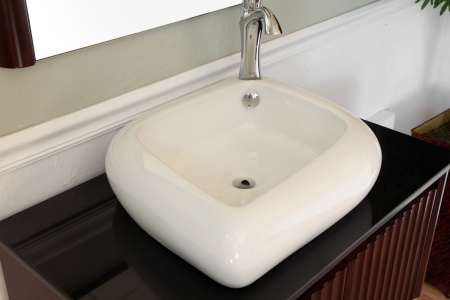
Do You Want a Deck Mounted or Wall Mounted Vessel Faucet?
If you choose a deck-mounted faucet – one that mounts directly to your counter – you'll just need to make sure that the hot and cold fixtures are spaced in such a way that they will line up with your current plumbing. If they do not, you will need to talk with a contractor about refitting the plumbing in your bathroom vanity to fit the faucet and knobs that you want.
Wall mounted faucets and knobs are classy and unique. They come in a variety of modern and traditional looks, with styles ranging from farm spigot lookalikes to waterfall faucets. The important thing to think about here, though, is your plumbing. If you choose a wall-mounted faucet, you are going to need to have a professional refit all of the supply lines for your bathroom vanity. This is not an inexpensive job, and you'll need to consider the time and money that will go into changing out all of the pipes in this area.
We certainly don't want to discourage you from purchasing the faucet that you want. Bathroom vanities with vessel sinks and wall-mounted faucets can be incredibly beautiful. They can add a sense of ambience and style to your bathroom that will make your morning and evening bath rituals more relaxing and enjoyable.
If you have your heart set on a wall-mounted faucet, you may just want to allot a bit more money and time to your bathroom vanity project. If you know these things before you make any purchases, you'll be able to weigh all of your options and how much each will cost.
If you're planning on selling your home in the next few years, you may want to opt for the least expensive upgrades to your bathroom. A top-mounted vessel sink and deck-mounted faucet aren't that hard to install, yourself. You could save money and increase the value of your home at a great price.
However, if you're going to be in this home for many years, you're probably not thinking as much about the resale value of your house as much as your enjoyment of the amenities in it. Take a look at all of your options and find the best one for your budget, and never hesitate to call the professionals, whether it's for installation or just for a consultation on cost and effort for the project.

Wall Mounted Bathroom Sink Faucets: Pros and Cons
This is a common question we get from clients calling in when designing their bathroom remodeling project. Wall mounted bathroom sink faucets are now growing in popularity, so we thought it would be pertinent to give a brief overview of why we think they "rock," or not.
As far as "pros" are concerned, this style of faucet is mounted above the sink, so there is obviously more space on the countertop to put various bathroom accessories that you might need in your daily routine. Additionally, since this style is just now becoming more "en vogue," you don't see a lot of them in bathrooms. So the "wow" factor is definitely there as well.
There are a few negatives to this style of products however. For one, some of these styles are a bit more expensive. On top of that, to successfully install a wall mounted faucet it needs to be roughed in the exact location of the sink which requires opening up the sheetrock and making sure the faucet and drain are exactly where you want them. To the average DIY person, this can be a little complicated!
Vessel Sink Faucet Placement
How High Should a Faucet Be Above a Vessel Sink?
The standard height for any sink and faucet is at least 6 inches from the bottom of the sink to the spout. This gives a good height for ease of washing your hands be it adults or children. Vessel faucets are generally anywhere from 12 to 17 inches in height. The most important thing you want to consider is placement of it. You want to make sure the water runs directly in the center of the drain to prevent splashing.
How Far Should the Faucet Be From a Vessel Sink?
Check out this post that discusses the distance needed between a vessel sink and faucet.
How High Should A Wall Mount Faucet Be From The Sink?
With the increasing popularity of vessel sinks, wall mount faucets have been showing up in more and more bathroom remodels. As an alternative to the single hole, more common vessel sink faucet, wall mount faucets are not mounted on the wall behind the sink. Though theycan be used for undermount sinks, they rarely are because the distance between the spout and the bottom of the sink is too great.
So, when considering a vessel sink with a wall mount faucet, it's important to plan the placement of the faucet so that you avoid the "splash factor" that commonly occurs with vessel sinks. So, to help with this, we asked our resident Contractor about the standard height it should be above the sink. He says that the faucet should be mounted 4″-6″ from the bottom of the spout to the bottom of the sink.
How to Choose the Correct Vessel Sink Drain
Grid Drains Vs. Pop-Up Drains
Two popular styles rule the world of bathroom sink drains: grid drains and pop-up drains. A grid drain is just a cap over the opening of your drainpipe that's perforated, usually with a series of round holes, though sometimes they're square or diamond-shaped. Pop-up drains are the more traditional style for older bathroom sinks. They consist of a plug with a lever system that can be sealed to keep water in the sink and popped up to allow water to drain.
So, which type of vessel sink drain is better? Well, you'll need to think about your requirements for using your sink, and you'll need to take into account some considerations about your sink's construction.
Your Needs and Your Drain
Do you find that you need to fill your sink up with water regularly? You might do this to wash your face or if you have clothing that you wash by hand. If you do, you should keep in mind that grid drains do not seal closed. If you want to hold water in your sink, you'll need a drain plug that works with a grid drain if you go this route.
On the other hand, pop-up drains, while they do plug the drainpipe and allow you to fill the sink with water if you need to, also have a tendency to let a lot more material and debris, like hair, fibers, and skin flecks, pass through. A grid drain will trap large material and hair from entering your drainpipe, and this can prevent a clogged sink in the future.
Before you make your decision, think about how you'll be using the sink. If you dye your hair in your bathroom and use the sink to rinse, you'll be more successful with a grid drain, which won't catch and pull your hair down into the pipes. If, on the other hand, you wash your delicates in your bathroom sink regularly, you may want a pop-up grid drain.
Drain Assembly Requirements and Materials
You may find that most of the bathroom vanities with vessel sinks that you see in other people's homes and in restaurants or spas have grid drains. This is because pop-up drains require a lever system to pop the drain plug up so that it may let water empty out of the sink. With traditional sinks, this mechanism is attached to the faucet and is hidden from sight either in the sink or under the bathroom vanity counter.
Depending upon the vessel sink faucet you purchase, you may not have the ability to install a pop-up drain. Many of these faucets do not come equipped with the plunger and lever system that you push down to pop the drain plug up. You can find some faucets that are designed for pop-up drains, but most of the waterfall faucets and wall-mounted faucets will not accommodate a pop-up drain, and a grid drain may be your only option.
Whichever design you choose, think about the finish of the drain and how it will match the rest of your bathroom fixtures. Drains come in a huge variety of materials and finishes. You can get them in chrome, stainless steel, nickel, copper, brass, and other materials, too.
Do Vessel Sinks Splash?
The quick answer is yes they can splash, but this can be mitigated with a few simple solutions.
How to Reduce Splashing with Vessel Sinks?
The first solution is to choose a faucet that sits a little bit lower or closer to the sink bowl. And, if your counter top allows for it, move the faucet back a little bit. This all has to be done obviously during installation. This is a good fix if you are working with a slightly smaller vessel sink. For instance, if you were using a smaller sink and an average height faucet, you will end up with more space between the two, making splashing a distinct possibility. So if you opt for a shorter faucet at the beginning, you can avoid this issue. Talk to and work with your retailer to help you make certain the faucet isn't too tall and that the sink bowl you choose isn't too small.
The other possibility is that the water pressure is a bit too high. Simply go under the sink cabinet and locate the water shut off valve. Turn on the faucet full blast; with a pair of pliers gently turn down the water pressure. Adjust as needed until the water pressure is just right for your sink. This will keep the faucet from blasting too much water from the spout which will prevent splashing.
How To Clean Around the Base of a Vessel Sink?
If you're a "clean freak" like we are here, and you've got a vessel sink in your home, then the chances are good that you've probably wondered the best way to clean around the base of your vessel – that tight round edge where the base of the sink connects with the countertop. Here's the ugly truth of the beautiful sink matter: there is NO easy way to do it. I know, total let down right? We asked our Contractor what he felt the best method to clean this hard to reach spot was and he mentioned that the best way is to take a thin cloth and using a "sawing" motion pull it back and forth against the rounded edges.
Additional Resources
- Houzz Vessel Sink Photos
- How to Choose the Right Vessel Sink
- The Right Height for Your Sinks, Mirrors and More
Source: https://www.uniquevanities.com/bathroom-vanity-blog/bathroom-essentials/pros-cons-vessel-sinks.html







Tidak ada komentar:
Posting Komentar